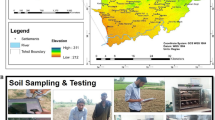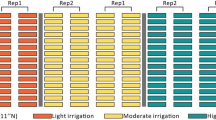Abstract
Implementing intelligent irrigation and adjusting the irrigation system is essential in today’s agricultural system to control the amount of water required for the plant. This study focuses on data obtained from sensors measuring (soil temperature and humidity, temperature and humidity of ambient and light) and image processing of plant leaves. To analyze the data, two models were implemented including a regression model in SPSS software and another model by genetic programming in MATLAB 2018 software. The optimal model was a combined model of sensors and images in genetic programming with higher R2 and lower standard error of 0.88 and 0.03, respectively. This model was superior to the regression model which had an R2 and standard error of 0.86 and 0.21, respectively, so this optimal model was selected to adjust the microcontroller for the intelligent irrigation system. The following year by replanting the crop, the intelligent irrigation system was presented as the superior system with 11% water saving compared to the previous year (irrigation by the user). Also, no changes were observed in the yield and color indicators of the plant at the level of 5%, which indicates the superiority of the intelligent irrigation system and its high accuracy of this system.











Similar content being viewed by others
Data availability
The data supporting the findings of this study are available upon reasonable request from the corresponding authors.
References
Ashofteh PA, Bozorg-Haddad O, Loáiciga HA (2019) Application of bi-objective genetic programming (BO-GP) for optimizing irrigation rules using two reservoir performance criteria. Int J River Basin Manage 19:1–35. https://doi.org/10.1080/15715124.2019.1613415
Baaghideh M, Entezari A, Kordi A (2019) Investigation of the relationship between soil temperature and climate parameters in the Northwest of Iran (1992–2015). J Geogr Reg Dev Res 16(1):279–307
Bagheri N (2019) Information technology is an infrastructure for the development of intelligent agriculture. Agri Inf Sci Technol 2(1):35–49 ((In Farsi))
Barikloo A, Alamdari P, Moravej K, Servati M (2017) Prediction of irrigated Wheat yield by using hybrid algorithm methods of artificial neural networks and genetic algorithm. J Water Soil 31(3):715–726
Behmann J, Steinrücken J, Plümer L (2014) Detection of early plant stress responses in hyperspectral images. J Int Soc Photogramm Remote Sensing (ISPRS) 93:98–111. https://doi.org/10.1016/j.isprsjprs.2014.03.016
Barkunan SR, Bhanumathi V, Sethuram J (2019) Smart sensor for automatic drip irrigation system for paddy cultivation. Comput Electr Eng 73:180–193. https://doi.org/10.1016/j.compeleceng.2018.11.013
Biabi H, Mehdizadeh SA, Salmi MS (2019) Design and implementation of a smart system for water management of Lilium flower using image processing. Comput Electron Agric 160:131–143
Boursianis AD, Papadopoulou MS, Diamantoulakis P, Liopa-Tsakalidi A, Barouchas P, Salahas G, Goudos SK (2022) Internet of Things (IoT) and agricultural unmanned aerial vehicles (UAVs) in smart farming: a comprehensive review. Int Things 18:100187
Conception R II, Lauguico S, Alejandrino J, Dadios E, Sybringco E, Bandala A (2022) Aquaphotomics determination of nutrient biomarker for spectrophotometric parameterization of crop growth primary macronutrients using genetic programming. Inf Process Agri 9:497–513
García L, Parra L, Jimenez JM, Parra M, Lloret J, Mauri PV, Lorenz P (2021) Deployment strategies of soil monitoring WSN for precision agriculture irrigation scheduling in rural areas. Sensors 21(5):1693
Gholizadeh A, Saberioon M, Viscarra Rossel RA, Boruvka L, Klement A (2020) Spectroscopic measurements and imaging of soil color for field-scale estimation of soil organic carbon. Geoderma 357(113972):1–10. https://doi.org/10.1016/j.geoderma.2019.113972
Guven A, Kisi O (2011) Daily pan evaporation modeling using linear genetic programming technique. Irrig Sci 29:135–145
Gonzales-Briones A, Castellanos-Garzon JA, Mezquita Martin Y, Prieto J, Corchado JM (2018) A framework for knowledge discovery from wireless sensor networks in rural environment: a crop irrigation systems case study. Wirel Commun Mobile Comput. https://doi.org/10.1155/2018/6089280
Guo X (2021) Application of agricultural IoT technology based on 5 G network and FPGA. Microprocess Microsyst 80(103597):1–5. https://doi.org/10.1016/j.micpro.2020.103597
Karthikeyan L, Mishra AK (2021) Multi-Layer high-resolution soil moisture estimation using machine learning over the United States. Remot Sensing Environ. 266:112706. https://doi.org/10.1016/j.rse.2021.112706
Kohzadi S, Marzban N, Libra JA, Bundschuh M, Maleki A (2023) Removal of RhB from water by Fe-modified hydrochar and biochar-An experimental evaluation supported by genetic programming. J Mol Liq 369:120971
Krízova K, Kaderabek J, Novak V, Linda R, Kuresova G, Sarec p, (2022) Using a single-board computer as a low-cost instrument for SPAD value estimation through color images and chlorophyll-related spectral indices. Eco Inform 67(101496):1–9. https://doi.org/10.1016/j.ecoinf.2021.101496
Khoshamoz G (2021) Review of integrating IoT and GIS potential to improve agriculturally activities. J GIS RS Appl Plan. 12(2):1–21 ((In Farsi))
Lei Y, Zhang H, Chen F, Zhang L (2016) How rural land use management facilitates drought risk adaptation in a changing climate- A case study in arid northern China. Sci Total Environ 550:192–199. https://doi.org/10.1016/j.scitotenv.2016.01.098
Lloret J, García L, Jimenez JM, Sendra S, Lorenz P (2021) Cluster-based communication protocol and architecture for a wastewater purification system intended for irrigation. IEEE Access 9:142374–142389
Miloudi L, Rezeg K (2018) Leveraging the power of Integrated solutions of IoT and GIS. In: At the 2018 3rd International conference on pattern analysis and intelligent systems (PAIS). https://doi.org/10.1109/PAIS.2018.8598500.
Nadafzadeh M, Abdanan Mehdizadeh S, Soltanikazemi M (2018) Development of computer vision system to predict peroxidase and polyphenol oxidase enzymes to evaluate the process of banana peel browning using genetic programming modeling. Sci Hortic 213:201–209. https://doi.org/10.1016/j.scienta.2017.12.047
Osroosh Y, Peters RT, Campbell CS, Zhang Q (2015) Automatic irrigation scheduling of apple trees using theoretical crop water stress index with an innovative dynamic threshold. Comput Electron Agric 118:193–203
Patankar N, Charmal M, Bhaskar N, Janrao S, Kamble A (2021) A Wi-Fi based smart irrigation monitoring for an agricultural environment. Book Recent Trends Intens Comput. https://doi.org/10.3233/APC210237
Pérez-Rodríguez F, Gómez-García E (2019) Codelplant: Regression-based processing of RGB images for colour models in plant image segmentation. Comput Electron Agric 163(104880):1–3
Pincheira M, Vecchio M, Giaffreda R, Kanhere SS (2021) Cost-effective IoT devices as trustworthy data sources for a blockchain-based water management system in precision agriculture. Comput Electron Agric 180(105889):1–9
Pourgholam-Amiji M, Liaghat A, Ahmadaali Kh (2021) Modeling of design and implementation cost of drip irrigation systems. Irrig Drain Struct Eng Res 22(82):1–22
Rahimi Jahangirlou M (2021) Agronomic and breeding strategies and smart technologies for mitigating drought stress impacts on crop plants. Agri Inf Sci Technol 3(6):1–22 ((In Farsi))
Sabzi S, Pourdarbani R, Rohban MH, García-Mateos G, Arribas JI (2021) Estimation of nitrogen content in cucumber plant (Cucumis sativus L.) leaves using hyperspectral imaging data with neural network and partial least squares regressions. Chemo Int Lab Syst. 217(104404):1–14
Sabziparvar AA, Zare Abyaneh H, Bayat Varkeshi M (2010) A model comparison between predicted soil temperatures using ANFIS model and regression methods in three different climates. J Water Soil 24(2):274–285
Sanuade OA, Hassan AM, Akanji AO, Olaojo AA, Oladunjoye MA, Abdulraheem A (2020) New empirical equation to estimate the soil moisture content based on thermal properties using machine learning techniques. Arabian J Geosci 13:1–4. https://doi.org/10.1007/s12517-020-05375-x
Shafi U, Mumtaz R, Gracia-Nieto J, Hassan SA, Zaidi SAR, Iqbal N (2019) Precision agriculture techniques and practices: from consideration to applications. Sensors 19(17):3796
Sharma R, Kamble SS, Gunasekaran A (2018) Big GIS analytics framework for agriculture review identifying the current trends and future perspectives. Comput Electron Agric 155:103–120
Sheikh JA, Cheema SM, Ali M, Amjad Z, Tariq JZ, Naz A (2020) IoT and AI in precision agriculture: designing smart system to support illiterate farmers. International Conference on Applied Human Factors and Ergonomics. Springer, Cham, pp 490–496
Shi P, Wang Y, Xu J, Zhao Y, Yang B, Yuan Z, Sun Q (2020) Rice nitrogen nutrition estimation with RGB images and machine learning methods. Comput Electr Agri 180:105860. https://doi.org/10.1016/j.compag.2020.105860
Singh PK, Sharma A (2022) An intelligent WSN-UAV-based IoT framework for precision agriculture application. Comput Electr Eng 100(107912):1–17
Taki M, Ajabshirchi Y, Ranjbar SF, Rohani A, Matloobi M (2016) Prediction of soil temperature and inside air humidity in a semisolar greenhouse equipped with cement north wall by artificial neural network; case study: Tabria city. Agri Mech 3(1):71–83 ((In Farsi))
Tzounis A, Katsoulas N, Bartzanas T, Kittas C (2017) Internet of things in agriculture, recent advances and future challenges. Biosys Eng 164:31–48
Wang P, Hafshejani BA, Wang D (2021) An improved multilayer perceptron approach for detecting sugarcane yield production in IoT-based smart agriculture. Microprocess Microsyst 82(103822):1–7
Wen C, Lu M, Bi Y, Zhang Sh, Xue B, Zhang M, Zhou Q, Wu W (2022) An object-based genetic programming approach for cropland field extraction. Remote Sensing 14(1275):1–17. https://doi.org/10.3390/rs14051275
Wong P, Wong WK, Juwono FH, Lease BA, Gopal L, Chew IM (2023) Sensor abnormality detection in multistage compressor units: a white box approach using tree-based genetic programming. e-Prime-Adv Electr Eng Energy 5:100209–100298
Zhao W, Sanchez N, Lu H, Li A (2018) A spatial downscaling approach for the SMAP passive surface soil moisture product using random forest regression. J Hydrol 563:1009–1024
Acknowledgements
The present investigation forms an integral component of a doctoral thesis conducted at the Department of Agricultural Machinery Engineering, situated within the esteemed Agricultural Sciences and Natural Resources University of Khuzestan, Mollasani, Iran. The authors of this study express their gratitude towards the university for providing financial assistance towards the completion of this research. Additionally, we extend our sincere appreciation to the anonymous reviewer for their valuable comments and insightful suggestions on the manuscript.
Author information
Authors and Affiliations
Corresponding author
Ethics declarations
Conflict of interest
The authors declare that they have no known competing financial interests or personal relationships that could have appeared to influence the work reported in this paper. This work was supported by the Agricultural Sciences and Natural Resources University of Khuzestan.
Additional information
Publisher's Note
Springer Nature remains neutral with regard to jurisdictional claims in published maps and institutional affiliations.
Rights and permissions
Springer Nature or its licensor (e.g. a society or other partner) holds exclusive rights to this article under a publishing agreement with the author(s) or other rightsholder(s); author self-archiving of the accepted manuscript version of this article is solely governed by the terms of such publishing agreement and applicable law.
About this article
Cite this article
Behzadipour, F., Ghasemi Nezhad Raeini, M., Abdanan Mehdizadeh, S. et al. A smart IoT-based irrigation system design using AI and prediction model. Neural Comput & Applic 35, 24843–24857 (2023). https://doi.org/10.1007/s00521-023-08987-y
Received:
Accepted:
Published:
Issue Date:
DOI: https://doi.org/10.1007/s00521-023-08987-y




